
Cephalissa is a monotypic moth genus in the family Geometridae. Its only species, Cephalissa siria, the orange triangle moth, is endemic to New Zealand. This species has been classified as nationally vulnerable by the Department of Conservation. It has suffered a contraction of its range, no longer being seen in Dunedin or Invercargill. It is currently found in the Mt Watkin Scenic Reserve, in eastern Otago, in the Rongahere Gorge and in the Dansey Ecological District. C. siria is known to inhabit kahikatea forest amongst Carex species as well as short tussock grasslands and shrubland. The larval host plant is Fuchsia perscandens. Adult moths are on the wing in October and November.
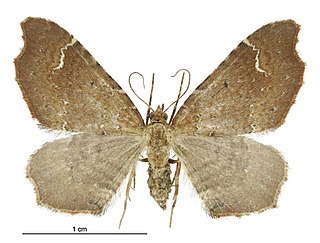
Asaphodes camelias is a species of moth in the family Geometridae. It is endemic to New Zealand, has been observed in both the North and South Islands and inhabits native forest. The adults of this species are on the wing from February to May and July to September.

Asaphodes chionogramma is a moth in the family Geometridae. It is endemic to New Zealand and found in both the North and South Islands. This species inhabits the lower slopes of mountains in valleys with native forest at altitudes of between 2000 and 3000 ft. The adults of this species are on the wing in December and January.

Asaphodes chlamydota is a moth in the family Geometridae. It is endemic to New Zealand, and can be found in the lower part of the North Island and in the South Island. It inhabits native forest and shrublands. The larvae of this species feeds on native Clematis plants including Clematis afoliata. Adults are on the wing from November to April and are regarded as having intermedia flight powers.

Asaphodes chlorocapna is a species of moth in the family Geometridae. This species is endemic to New Zealand and can only be found in the Chatham Islands. The larvae of this species consume the leaves of Muehlenbeckia plants. Adults are on the wing in January. This species is classified as "At Risk, Relict'" by the Department of Conservation.

Asaphodes cosmodora is a species of moth in the family Geometridae. This species is endemic to New Zealand and has been observed in the South Island. The adults of this species are on the wing in January and February.
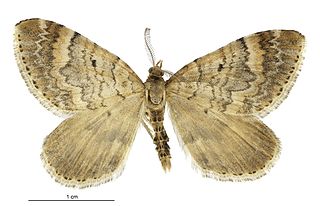
Asaphodes dionysias is a species of moth in the family Geometridae. This species is endemic to New Zealand and is only known from mountainous areas in Central Otago. It lives in open grassy mountainous habitat at altitudes up to 1750 m. It is also known to live in wetland habitat. The larvae of this species feed on native herbs. The adults of this species are on the wing in January and February. The adult female of the species has reduced wing size in comparison to the male.
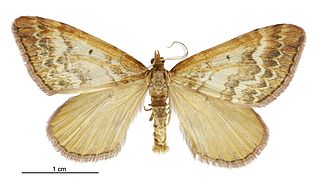
Asaphodes helias is a species of moth in the family Geometridae. It is endemic to New Zealand. It has been found in the middle and southern parts of the South Island. This species frequents tussock and scrubby habitat. The host plants of the larvae of this species include Cardamine and Ranunculus species. They have also been witnessed feeding on exotic buttercup species in the genus Bellis. Adults are on the wing in January and February.
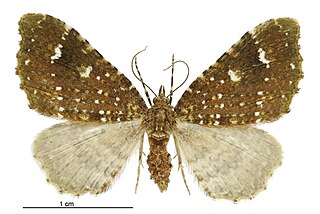
Asaphodes limonodes is a species of moth in the family Geometridae. It is endemic to New Zealand and is found in both the North and South Islands. This species inhabits damp native forest. Adults are on the wing from November until March.
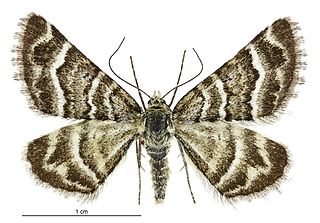
Notoreas paradelpha is a species of moth in the family Geometridae. It is endemic to New Zealand.

Orthoclydon chlorias is a species of moth in the family Geometridae. It is endemic to New Zealand.
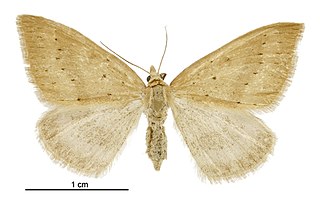
Asaphodes mnesichola is a species of moth in the family Geometridae. It is endemic to New Zealand and has been observed in the South Island. This species inhabits subalpine native scrub. Adults of this species are on the wing in January and February.

Asaphodes omichlias is a moth in the family Geometridae. It is endemic to New Zealand and has been observed in both the North and South Islands. This species inhabits rocky, open country in high mountains. Adults are on the wing in January and February. The appearance of the adult of this species is variable with some specimens having a paler and more grey appearance than the more usual brown appearance. Its colouration ensures it blends well with its preferred habitat rocky, open country in the high mountains.
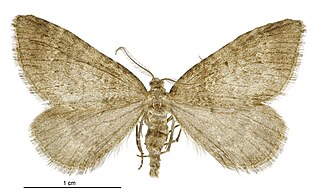
Asaphodes periphaea is a moth in the family Geometridae. It is endemic to New Zealand and has only been collected in the mountains near Lake Wakatipu in the South Island. The male is fuscous coloured sprinkled with whitish colouration. The female is brachypterous. The preferred habitat of this species are alpine bluffs as well as mountainous open country. This species is on the wing from January to March.

Asaphodes prasinias is a moth in the family Geometridae. It is endemic to New Zealand and has been found on both the North and South Islands. This species inhabits native forest including beech forest and subalpine scrub. The range of this species has reduced as this species is regarded as being locally extinct in the previously inhabited open non-forest habitats around Invercargill. Adults are on the wing from November to January.

Asaphodes prymnaea is a moth in the family Geometridae. It is endemic to New Zealand and can be found on the Mount Arthur tableland. It is common in limestone valleys. The female of the species is paler and has less distinctive markings than the male. Adults are on the wing in January and February.

Asaphodes sericodes is a moth in the family Geometridae. It is endemic to New Zealand and has been observed in the southern parts of the South Island. This species inhabits open tussock grasslands in subalpine scrub or wetlands. The female of the species is likely semi-apterous and is flightless. The adult males are on the wing in January.

Atomotricha chloronota is a moth in the family Oecophoridae first described by Edward Meyrick in 1914. It is endemic to New Zealand and is found in the eastern side of the South Island and at the Antipodes Islands. It inhabits clearings with native tussocks and ferns. The larvae feed on leaf litter from silk tunnels in soil. The male adults of this species are on the wing from July to September and have been trapped via sugar traps and are attracted to light. The female of this species is brachypterous.
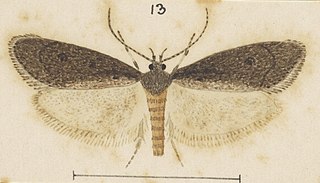
Atomotricha ommatias is a moth in the family Oecophoridae first described by Edward Meyrick in 1883. It is endemic to New Zealand and has been observed in the South Island. This species inhabits shrubland. The adults are out in the spring months of August and September and are attracted to sugar traps. The female of the species os brachypterous and is incapable of flight. Both the male and female of the species have been observed resting on fences during cold nights. The female, if touched, will hop two or three inches.

Atomotricha sordida is a moth in the family Oecophoridae first described by Arthur Gardiner Butler in 1877. It is endemic to New Zealand and has been observed in the South Island in the Canterbury and Otago regions. The adult female of the species is brachypterous.






















